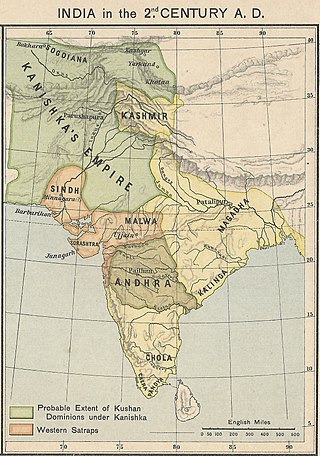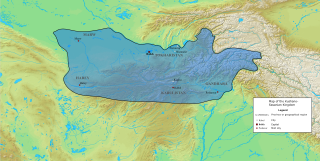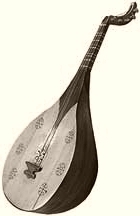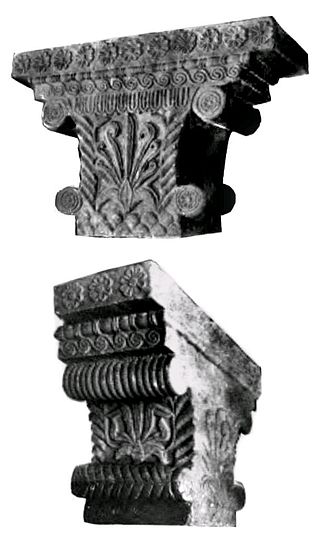
A lute is any plucked string instrument with a neck and a deep round back enclosing a hollow cavity, usually with a sound hole or opening in the body. It may be either fretted or unfretted.

Bactria, or Bactriana, was an ancient Iranian civilization in Central Asia centered on modern day Northern Afghanistan and including parts of southwestern Tajikistan and southeastern Uzbekistan.

The oud is a short-neck lute-type, pear-shaped, fretless stringed instrument, usually with 11 strings grouped in six courses, but some models have five or seven courses, with 10 or 13 strings respectively.

The Yuezhi (Chinese: 月氏; pinyin: Yuèzhī, Ròuzhī or Rùzhī; Wade–Giles: Yüeh4-chih1, Jou4-chih1 or Ju4-chih1;) were an ancient people first described in Chinese histories as nomadic pastoralists living in an arid grassland area in the western part of the modern Chinese province of Gansu, during the 1st millennium BC. After a major defeat at the hands of the Xiongnu in 176 BC, the Yuezhi split into two groups migrating in different directions: the Greater Yuezhi (Dà Yuèzhī 大月氏) and Lesser Yuezhi (Xiǎo Yuèzhī 小月氏). This started a complex domino effect that radiated in all directions and, in the process, set the course of history for much of Asia for centuries to come. The Greater Yuezhi initially migrated northwest into the Ili Valley (on the modern borders of China and Kazakhstan), where they reportedly displaced elements of the Sakas. They were driven from the Ili Valley by the Wusun and migrated southward to Sogdia and later settled in Bactria. The Greater Yuezhi have consequently often been identified with peoples mentioned in classical European sources as having overrun the Greco-Bactrian Kingdom, like the Tókharioi (Greek Τοχάριοι; Sanskrit Tukhāra) and Asii (or Asioi). During the 1st century BC, one of the five major Greater Yuezhi tribes in Bactria, the Kushanas (Chinese: 貴霜; pinyin: Guìshuāng), began to subsume the other tribes and neighbouring peoples. The subsequent Kushan Empire, at its peak in the 3rd century AD, stretched from Turfan in the Tarim Basin in the north to Pataliputra on the Gangetic plain of India in the south. The Kushanas played an important role in the development of trade on the Silk Road and the introduction of Buddhism to China.

The Kushan Empire was a syncretic empire, formed by the Yuezhi, in the Bactrian territories in the early 1st century. It spread to encompass much of what is now Uzbekistan, Afghanistan, Pakistan and Northern India, at least as far as Saketa and Sarnath near Varanasi (Benares), where inscriptions have been found dating to the era of the Kushan Emperor Kanishka the Great.

Greco-Buddhism, or Graeco-Buddhism, is the cultural syncretism between Hellenistic culture and Buddhism, which developed between the 4th century BC and the 5th century AD in Gandhara, in present-day north-western Pakistan and parts of north-east Afghanistan.

The Greco-Buddhist art or Gandhara art is the artistic manifestation of Greco-Buddhism, a cultural syncretism between Ancient Greek art and Buddhism. It had mainly evolved in the ancient region of Gandhara, located in the northwestern fringe of the Indian subcontinent.
The Kidarites, or Kidara Huns, were a dynasty that ruled Bactria and adjoining parts of Central Asia and South Asia in the 4th and 5th centuries. The Kidarites belonged to a complex of peoples known collectively in India as the Huna, and in Europe as the Chionites, and may even be considered as identical to the Chionites. The 5th century Byzantine historian Priscus called them Kidarite Huns, or "Huns who are Kidarites". The Huna/Xionite tribes are often linked, albeit controversially, to the Huns who invaded Eastern Europe during a similar period. They are entirely different from the Hephthalites, who replaced them about a century later.

Kushano-Sasanian Kingdom is a historiographic term used by modern scholars to refer to a branch of the Sasanian Persians who established their rule in Bactria during the 3rd and 4th centuries CE at the expense of the declining Kushans. They captured the provinces of Sogdiana, Bactria and Gandhara from the Kushans in 225 CE. The Sasanians established governors for the Sasanian Empire, who minted their own coinage and took the title of Kushanshas, i.e. "Kings of the Kushans". They are sometimes considered as forming a "sub-kingdom" inside the Sasanian Empire. This administration continued until 360-370 CE, when the Kushano-Sasanians lost much of its domains to the invading Kidarite Huns, whilst the rest was incorporated into the imperial Sasanian Empire. Later, the Kidarites were in turn displaced by the Hephthalites. The Sasanians were able to re-establish some authority after they destroyed the Hephthalites with the help of the Turks in 565, but their rule collapsed under Arab attacks in the mid 7th century.

The barbat or barbud was a lute of Central Asian or Greater Iranian or Persian origin. Barbat is characterized as carved from a single piece of wood, including the neck and a wooden sound board. Possibly a skin-topped instrument for part of its history, it is ancestral to the wood-topped oud and biwa and the skin-topped Yemeni qanbus.

Dalverzin Tepe is an ancient archaeological site founded by the Graeco-Bactrian Kingdom and located near to the modern city of Denau in the Surxondaryo Region of Uzbekistan. The city was founded in the 3rd century BC and rose to prominence in the Kushan period when two important Buddhist temples were built here. Dalverzin Tepe was excavated by the famed Soviet archeologist Galina Pugachenkova.

Indo-Greek art is the art of the Indo-Greeks, who reigned from circa 200 BCE in areas of Bactria and the Indian subcontinent. Initially, between 200 and 145 BCE, they remained in control of Bactria while occupying areas of Indian subcontinent, until Bactria was lost to invading nomads. After 145 BCE, Indo-Greek kings ruled exclusively in parts of ancient India, especially in Gandhara, in what is now present-day the northwestern Pakistan. The Indo-Greeks had a rich Hellenistic heritage and artistic proficiency as seen with the remains of the city of Ai-Khanoum, which was founded as a Greco-Bactrian city. In modern-day Pakistan, several Indo-Greeks cities are known such as Sirkap near Taxila, Barikot, and Sagala where some Indo-Greek artistic remains have been found, such as stone palettes. Some Buddhist cultural objects related to the Indo-Greeks are known, such as the Shinkot casket.By far the most important Indo-Greek remains found are numerous coins of the Indo-Greek kings, considered as some of the most artistically brilliant of Antiquity. Most of the works of art of the Greco-Buddhist art of Gandhara are usually attributed to the direct successors of the Indo-Greeks in Ancient India in the 1st century CE, such as the nomadic Indo-Scythians, the Indo-Parthians and, in an already decadent state, the Kushans. Many Gandharan works of art cannot be dated exactly, leaving the exact chronology open to interpretation. With the realization that the Indo-Greeks ruled in India until at least 10-20 CE with the reign of Strato II in the Punjab, the possibility of a direct connection between the Indo-Greeks and Greco-Buddhist art has been reaffirmed recently.

Central Asian art is visual art created in Central Asia, in areas corresponding to modern Kyrgyzstan, Kazakhstan, Uzbekistan, Turkmenistan, Azerbaijan, Tajikistan, Afghanistan, Pakistan, and parts of modern Mongolia, China and Russia. The art of ancient and medieval Central Asia reflects the rich history of this vast area, home to a huge variety of peoples, religions and ways of life. The artistic remains of the region show a remarkable combinations of influences that exemplify the multicultural nature of Central Asian society. The Silk Road transmission of art, Scythian art, Greco-Buddhist art, Serindian art and more recently Persianate culture, are all part of this complicated history.

Kara Tepe is a Buddhist archaeological site in the Central Asia region of Bactria, in the Termez oasis near the city of Termez in southern Uzbekistan. The foundations of the site date to the 1st century CE, with a peak of activity around the 3rd and 4th centuries during the Kushan period, before experiencing a fatal decline around the 5th century CE, probably with the invasion of the Kushano-Sassanian, whose coinage can be found on the site.

Hellenistic influence on Indian art and architecture reflects the artistic and architectural influence of the Greeks on Indian art following the conquests of Alexander the Great, from the end of the 4th century BCE to the first centuries of the common era. The Greeks in effect maintained a political presence at the doorstep, and sometimes within India, down to the 1st century CE with the Greco-Bactrian Kingdom and the Indo-Greek Kingdoms, with many noticeable influences on the arts of the Maurya Empire especially. Hellenistic influence on Indian art was also felt for several more centuries during the period of Greco-Buddhist art.

Gandhāran Buddhism refers to the Buddhist culture of ancient Gandhāra which was a major center of Buddhism in the northwestern Indian subcontinent from the 3rd century BCE to approximately 1200 CE. Ancient Gandhāra corresponds to modern day north Pakistan, mainly the Peshawar valley and Potohar plateau as well as Afghanistan's Jalalabad. The region has yielded the Gandhāran Buddhist texts written in Gāndhārī Prakrit the oldest Buddhist manuscripts yet discovered. Gandhāra was also home to a unique Buddhist artistic and architectural culture which blended elements from Indian, Hellenistic, Roman and Parthian art. Buddhist Gandhāra was also influential as the gateway through which Buddhism spread to Central Asia and China.

Lutes are stringed musical instruments that include a body and "a neck which serves both as a handle and as a means of stretching the strings beyond the body".

The mandolin is a modern member of the lute family, dating back to Italy in the 18th century. The instrument was played across Europe but then disappeared after the Napoleonic Wars. Credit for creating the modern bowlback version of the instrument goes to the Vinaccia family of Naples. The deep bowled mandolin, especially the Neapolitan form, became common in the 19th century, following the appearance of an international hit, the Spanish Students. They toured Europe and America, and their performances created a stir that helped the mandolin to become widely popular.

Kushan art, the art of the Kushan Empire in northern India, flourished between the 1st and the 4th century CE. It blended the traditions of the Greco-Buddhist art of Gandhara, influenced by Hellenistic artistic canons, and the more Indian art of Mathura. Kushan art follows the Hellenistic art of the Greco-Bactrian Kingdom as well as Indo-Greek art which had been flourishing between the 3rd century BCE and 1st century CE in Bactria and northwestern India, and the succeeding Indo-Scythian art. Before invading northern and central India and establishing themselves as a full-fledged empire, the Kushans had migrated from northwestern China and occupied for more than a century these Central Asian lands, where they are thought to have assimilated remnants of Greek populations, Greek culture and Greek art, as well as the languages and scripts which they used in their coins and inscriptions: Greek and Bactrian, which they used together with the Indian Brahmi script.

Tapa Shotor, also Tape Shotor or Tapa-e-shotor, was a large Sarvastivadin monastery near Hadda, Afghanistan, and is now an archaeological site. According to archaeologist Raymond Allchin, the site of Tapa Shotor suggests that the Greco-Buddhist art of Gandhara descended directly from the art of Hellenistic Bactria, as seen in Ai-Khanoum.


















